Our next biotope, by car 130 kilometres from Pontianak was 6-8 meters wide
and approx. 1,5 meters deep, and in fact of raining the river was very fast floating. Here
we did catch Trichopsis vittatus, Hemirhamphodon poponognathus, Rasbora cf. volzi, Rasbora
spec. as well as a Mastacembelus species. Biotope number 3 lay in a hill landscape with
beginning of fire clearance for paddy fields.
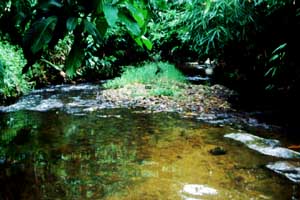 Biotope 3 a mountain stream © 2001
Michael Schlüter
Biotope 3 a mountain stream © 2001
Michael Schlüter
It looked like a river you normally see in the mountains. The river had many varied zones
with deep of 20 to 100 cm and a width of averagely 6 meters. Stone, gravel and sand zones
alternated. In spite of this strong structure wealth we caught only 2 barbs and a
Nemacheilus species, perhaps Nemacheilus borneesnsis. I had hoped for some hillstream
loaches. But we did not find any. Perhaps the river with a temperature of 28,5 °C in
spite of the strong movement had not enough oxygen for these fish? We have measured only
the pH factor with 6,8 and the conductance with 37 µS/ccm³. Regional this small river
was very delightful. The next biotope, 159 kilometres by car from Pontianak did surprise
me. A Hemirhamphodon species I had not seen before. I had read from this biotope already
with Roberts (1989). The species in this river was Hemirhamphodon phaiosoma. I also wanted
to catch these kind, however, did not know how they look. As first H. kapuasensis occurred
to me to this species who also has a red collateral line. The dorsal fin of Hemirhamphodon
phaiosoma was much longer than of H. phaiosoma. This small river lay in the hill country
with primary forest and beginning fire clearance at the end of a village and was used as a
washing place. Here it was 2 to 4 meters wide and 30 to 100 cm deep. The fast floating
water was ending in a small lake. It was weakly yellowish clearwater and had on 30/09/01
at 5.15 o clock p.m a temperature of 27 °C, pH factor 6,7 with 2 µS/ccm³. Here we could
catch by push net Barbus spec., Rasbora sumatrana, R. sarawakensis, Acantophtalmus
shelfordi, Nemacheilus selangoricus, Doryichthys spec., Channa striata and the
Hemirhamphodon phaiosoma.. From also interesting Doryichthys ssp. we could catch only a
unique specimen in almost five hours. This freshwater pipefish found under the hollowed
bank area.
For the next day we planned our first trip of several days to Sintang. We wanted to leave
our already caught fish in linen tubs and water-reserves for washing in the bathroom of
our pension. Most fish caught by us were well fed. For the daily water change we used the
water from the administration. This water came according to Kasigen from a river and was
suitable with a pH factor of 7,2 with 22 µS/ccm³, best for the clear water fish. For the
black water fish we got the water of our first catching side. This was already dirtied on
account of farming and clearing, we could state in the partly strong algae growth and the
conductivity high, unusual for black water. Because we have caught no ill fish, the water
seemed to us been suitable best, not at least for reason it lay surely near. For the
feeding of the fish we set on eggs of brine shrimp and attracted small ants which ran in
our bathroom, with some Mango. So we could feed several times a week. Our fifth catching
site was 360 kilometres far form Pontianak and lay in a hardly settled area of approx.
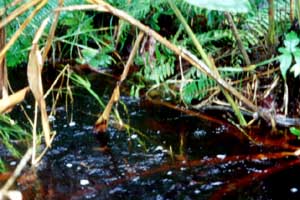 Biotope 5 a
small blackwater brook © 2001 Michael Schlüter Biotope 5 a
small blackwater brook © 2001 Michael Schlüter
10 kilometres behind Sekadau with secondary forest and our first Nepenthes at the natural
location. Also here wood was hit. A small, strongly floating, turbid blackwater river was
stopped by the street and flooded the bank.
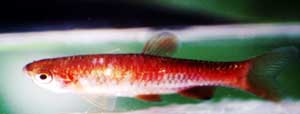
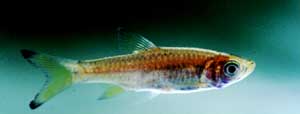
Rasbora kalochroma Biotope 4© 2001
Michael Schlüter Rasbora
sumatrana Biotope 7 © 2001 Michael Schlüter
Here we could catch Rasbora kalochroma, a silurid
catfish and young fish of a Betta species. The biggest Rasbora had a length of 6 cm and
were numerous in the turbulent area before the subway of the street. With a water
temperature of 27 °C at 6 o'clock p.m. we could measure a pH factor of 3,78 and 22
µS/ccm³. The Rasbora impressed us with their dark red body colour and therefore were
taken with us. After we stood to an overnight accommodation in a little bit peculiar hotel
in Sekadau, witch outed as a disorderly house, we drove northwest on a street to an
isolated mountain, shortly behind Sintang. Here we caught in two small clear water rivers.
In first (biotope 6) we caught Rasbora pauciperforata, Barbus pentazona and Luciocephalus
pulcher. In the second small river (biotope7) we could catch Hemirhamphodon poponognathus
and two species of Rasbora.
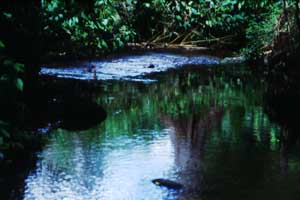 Biotope 7 a
small forest stream © 2001 Michael Schlüter Biotope 7 a
small forest stream © 2001 Michael Schlüter
On our way back after Pontianak our next
overnight accommodation was essentially more comfortable in Sintang. Nevertheless, we also
used here our mosquito nets around the pervasive insects to refuse. In the next morning,
03/10/01 we started early, because we stood in the direction of the type locality of
Hemirhamphodon kapuasensis. Naturally we wanted to look the way there around other
biotopes to catch fishes. Our eighth biotope was again beautiful, a clearwater river with
a temperature of 25 °C, pH factor 4,7 and 10 µS/ccm³. Here we could catch in single
quantities Barbus pentazona, some Rasbora spec. and R. dorsiocellata as well as Nandus
nebulosus, Pristolepsis spec., Mastacembelus spec. and a Mystus species. The next
discovery site was a clear ditch in which we found Rasbora kalochroma, R. pauciperforata,
R. sp. aff. sumatrana as well as many
Trichogaster trichopterus trichopterus.
Part 3
|
